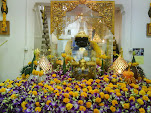 Ti Tsang P'usa is an extremely popular Bodhisattva among the Chinese and Japanese Buddhists. 'Ti Tsang', meaning 'Earth-Store' is a direct translation of the Bodhisattva's name KSITIGARBHA in Sanskrit. Among the countless Bodhisattvas in the universe, he and three others have firmly captured the hearts of the Mahayanists.
Ti Tsang P'usa is an extremely popular Bodhisattva among the Chinese and Japanese Buddhists. 'Ti Tsang', meaning 'Earth-Store' is a direct translation of the Bodhisattva's name KSITIGARBHA in Sanskrit. Among the countless Bodhisattvas in the universe, he and three others have firmly captured the hearts of the Mahayanists.These four main P'usas or Bodhisattvas are depicted in the Chinese Buddhist Pantheon and they represent four basic great qualities:
- KUAN SHIH YIN(观士音) as Great Compassion
- WEN SHU (文殊) as Great Wisdom
- PU HSIEN (普贤) as Great Love and Perfect Activity
- TI TSANG(地藏) as Great Vow to help and to deliver all beings.
Ti Tsang P'usa has often been mistaken by uninformed Buddhists to be Mogallana who was a disciple of Sakyamuni Buddha, because he too had a similar experience of descending to the Hell Realm to seek and save his mother. The stories may sound similar but they happened at different times and adopted quite different methods to save their mothers. Many others also tend to mistake Ti Tsang as Hsuan Tsang, the famous Tripitaka master of the Tang Dynasty who made the harzadous journey to the West to seek the Buddhist scriptures. This is mainly due to the Sangha robe and the five-leave crown which both are seen to wear. Ti Tsang P'usa is again taken by many to be "Yen-Lo-Wang" or Yama, the "Over-Lord of Hell." It must be mentioned that Ti Tsang is a Bodhisattva and not a mere King of the Fifth Hell. He does not judge the dead but seeks to save them from their suffering.
Ti Tsang may be represented in sitting or standing posture. He always has a kind and benevolent look and carries either, or both, his symbols of the Cintamani or "Wish-fulfilling Jewel' and the "Ringed-Staff", which is also called the Khakkhara. This ringed staff is often carried by Buddhist monks in their travels so that the sounds caused by the jingling rings can warn small animals and insects of their approach lest they be trod upon and killed. It is also sometimes called the alarm-staff. In the much treasured picture of Ti Tsang P'usa, which is found in many Buddhist homes and temples, he is seen seated upon a lotus throne. His hands holds the precious flaming pearl which has vast magical powers beyond description. He wears the robe of a Northern Buddhist monk and on his head is the "five-leave crown, where the representation of a Dhyani-Buddha can be seen on each of the leaves.Ti Tsang's compassion is not practised exclusively for the benefit of the beings of the hell realm, he also gives blessings to those of the world who seek his help and he is a comforter of the poor, oppressed, sick, hungry, and those who are troubled by spirits and nightmares. Those who have firm faith in him can easily receive his protection.
With faith one needs to recite any of these simple prayers:
"NAMO TI TSANG WANG P'USA' or"NAMO KSITIGARBHA BODHISATTVA YA".
The birthday of Ti Tsang P'usa falls on the 30th day of the 7th moon of the Chinese lunar calendar. All over the world Buddhist temples offer prayers to Ti Tsang P'usa during the 7th lunar month for the benefit of the dead. Ti Tsang's popularity among the Chinese and Japanese Buddhists is second only to Kuan Shih Yin P'usa as he takes upon himself the fearful and difficult task of bringing relief and consolation to the suffering beings of hell.
(source: http://www.buddhanet.net/)
胡


No comments:
Post a Comment